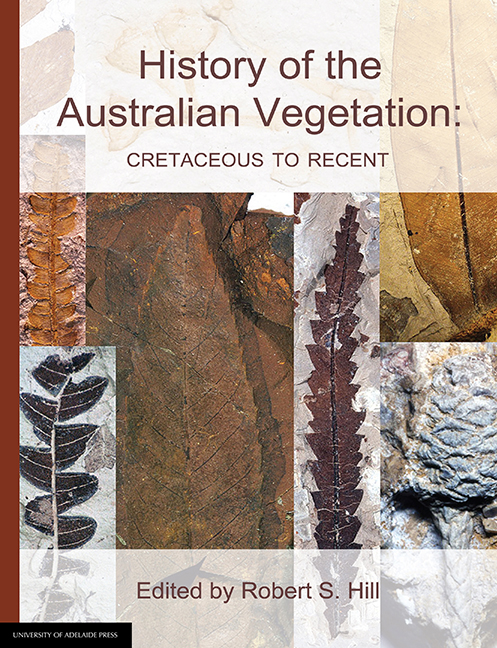Book contents
- Frontmatter
- Contents
- List of contributors
- Introduction to the 2017 edition
- 1 The Australian fossil plant record: an introduction
- 2 Maps of late Mesozoic-Cenozoic Gondwana break-up: some palaeogeographical implications
- 3 The background: 144 million years of Australian palaeoclimate and palaeogeography
- 4 Palaeobotanical evidence for Tertiary climates
- 5 Landscapes of Australia: their nature and evolution
- 6 Patterns in the history of Australia's mammals and inferences about palaeohabitats
- 7 Australian Tertiary phytogeography: evidence from palynology
- 8 Cretaceous vegetation: the microfossil record
- 9 Cretaceous vegetation: the macrofossil record
- 10 Early Tertiary vegetation: evidence from spores and pollen
- 11 The early Tertiary macrofloras of continental Australia
- 12 Cenozoic vegetation in Tasmania: macrofossil evidence
- 13 The Neogene: a period of transition
- 14 The Oligo-Miocene coal floras of southeastern Australia
- 15 Quaternary vegetation
- 16 The history of selected Australian taxa
- Taxonomic index
- General index
13 - The Neogene: a period of transition
Published online by Cambridge University Press: 25 July 2017
- Frontmatter
- Contents
- List of contributors
- Introduction to the 2017 edition
- 1 The Australian fossil plant record: an introduction
- 2 Maps of late Mesozoic-Cenozoic Gondwana break-up: some palaeogeographical implications
- 3 The background: 144 million years of Australian palaeoclimate and palaeogeography
- 4 Palaeobotanical evidence for Tertiary climates
- 5 Landscapes of Australia: their nature and evolution
- 6 Patterns in the history of Australia's mammals and inferences about palaeohabitats
- 7 Australian Tertiary phytogeography: evidence from palynology
- 8 Cretaceous vegetation: the microfossil record
- 9 Cretaceous vegetation: the macrofossil record
- 10 Early Tertiary vegetation: evidence from spores and pollen
- 11 The early Tertiary macrofloras of continental Australia
- 12 Cenozoic vegetation in Tasmania: macrofossil evidence
- 13 The Neogene: a period of transition
- 14 The Oligo-Miocene coal floras of southeastern Australia
- 15 Quaternary vegetation
- 16 The history of selected Australian taxa
- Taxonomic index
- General index
Summary
The Neogene was a time of transition both in the development of the present vegetation and the palynological study of it. The vegetation cover changed from one dominated by rainforest, which is traditionally regarded as ‘Tertiary’, to one in which rainforest became very reduced in extent. The nature of this change has been difficult to document due to an increasingly arid landscape with a concomitant reduction in suitable pollen preservation sites. The difficulty has been compounded by a relative lack of palynological study on the period. Stratigraphic palynologists have focussed on the earlier part of the Tertiary and there is no formal or well dated biostratigraphy, for much of the period under consideration, that is applicable to Australian terrestrial environments. Palynologists concerned with vegetation reconstruction have largely restricted their attention to the later part of the Quaternary period and have had variable success when venturing back into the Tertiary, as the vegetation then was frequently very different from that of today. Consequently, the database from which we piece together this critical period in Australia's vegetation history is very fragmentary and of varying quality.
In keeping with the problematic documentation of vegetation, there are difficulties in defining the period itself. There is general agreement on its beginning - the Miocene began about 25 million years (Ma) ago, although this does not necessarily hold any palynostratigraphic or biogeographical significance - but there are different views on the best location of the end of the period, i.e. the Pliocene/Pleistocene boundary. Conventionally this boundary is placed at the top of the Olduvai palaeomagnetic event dated to 1.6 Ma (Berggren et aL, 1985) but there is increasing pressure to reposition this close to the Gauss/Matuyama palaeomagnetic reversal boundary, around 2.4 Ma, as this reflects more closely the beginning of the substantial cooling and climatic fluctuations that characterise the Pleistocene period (Zagwin, 1985; Kukla, 1989).
PALAEOENVIRONMENTAL SETTING
Major factors influencing the whole of Australia during the Neogene include global climatic changes and the northward movement of the continent. The build up of ice on Antarctica, partly a result of the northward movement of Australia, which allowed the development of a circum-Antarctic ocean current, caused a steepening of the temperature gradient from equator to pole and development of the present atmospheric circulation pattern (Kemp, 1978).
- Type
- Chapter
- Information
- History of the Australian VegetationCretaceous to Recent, pp. 299 - 327Publisher: The University of Adelaide PressPrint publication year: 2017

